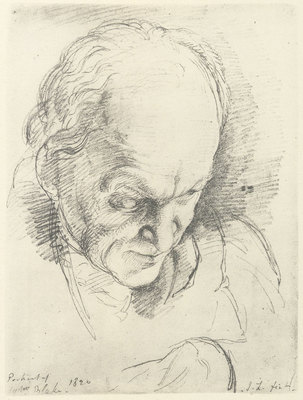About Blake
Author, artist, and printmaker William Blake was born in London in 1757. Even from a young age he created works in multiple media, combining his interests in writing and drawing. He began work as an apprentice engraver at age 14, later attending the Royal Academy of Art. In 1782 Blake married Catherine Boucher, who would be an anchor for Blake ever afterwards and help him with his sales and printmaking. The same decade saw Blake’s deepening involvement with radical thinkers, the publication of his first book of poems, the opening of a print shop, and his first experiments with “illuminated printing.” Blake would continue to develop and use this technique to combine text with imagery in the works for which he is now principally remembered. Hand-printed and colored, each copy of his original work is unique and exceptionally rare.
Nearly unrecognized in his own lifetime and always struggling financially, Blake spent the majority of his time in London. He sustained his personal work by accepting a variety of commissions and engraving work. He also lived during a brief period at Felpham in rural
Sussex, while working on a commission for the writer William Hayley. This experience ended badly, however, like some of Blake’s other commissioned work. While Blake’s relationship with patrons, publishers, and other authors, artists, and thinkers was often contentious, he developed close friendships with fellow artists such as John Flaxman and John Linnell. Their championship and support lay behind other important commissions and helped secure his legacy. Blake was working on a commission from Linnell for illustrations to Dante’s Divine Comedy when he died in London in 1827.
Blake’s passionate response to political, social, and religious constructs that he considered oppressive and misguided led to the formation of a personal mythology presented vividly in his poetry and illuminated books. The joining of his well-known Songs of Innocence to his slightly later Songs of Experience suggests the breadth of his outlook. He was raised as a Christian, was thoroughly familiar with the Bible, and was driven by unfailingly spiritual values. At the age of four, he believed that he had actually seen God. He easily depicted traditional views of religious inspiration and behavior such as those represented in his illustrations for the Bible and the Book of Job. Blake despised the idea of religion being a construct of government and rules, however, and he had similarly critical views of contemporary social conditions. Blake’s imaginative response to these issues is expressed in works such as The Marriage of Heaven and Hell, Jerusalem, and the “prophecies,” America and Europe. In the words of one of the figures, Los, who looms largest in Blake’s writings and mythology, the powerful originality of Blake’s approach might be summed up as: “I must create a system or be enslaved by another Man’s; I will not reason and compare: my business is to create.”



